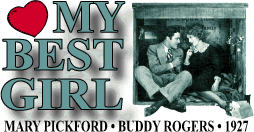

Maggie Johnson works at Merrill's Department Store as a stock girl. The new stock boy, Joe Grant, has just been assigned to her. What she doesn't know is that Joe is really Joe Merrill, the son of the store owner who has come to "prove himself" prior to marrying socialite Millicent. Maggie is the only strong member of her family of four which consists of a mother who attends funerals constantly but does no housework, a father who caters to the mother's idiosyncrasies, and a sister who is a flapper and dates a shady character pursued by the police. When Maggie invites Joe home for supper, the family is in the midst of one of their regular fights, and Maggie does everything she can to convince Joe they are practicing for a play. One evening, after they leave the store, Joe convinces Maggie to go to the Merrills' home because of the store slogan "We're all one big happy family." Joe's parents and his fiancée come home unexpectedly, and Maggie learns the truth about Joe. She leaves the house in tears. Joe now has three things to deal with - a woman he's engaged to, a family who disapproves of his romance with a shop girl, and his love for Maggie.
"Charles Rosher had just come from photographing 'Sunrise,'
and he employed the same care on this one. From the opening track
back from a cash register -- as five and ten cents are rung up
-- into a complex montage, all done in the camera, of department-store
merchandise -- cutlery, candles, hammers -- one is aware of being
in the hands of master filmmakers. The fluid technique and the
immaculate lighting are a joy to behold (particularly if you are
lucky enough to see an original tinted 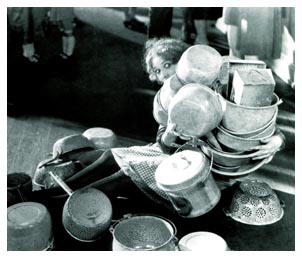 print
projected on a screen)."
print
projected on a screen)."
The above excerpt is from Mary Pickford Rediscovered (Harry N. Abrams, Inc., 1999) by Kevin Brownlow and gives an indication of the quality of the production the viewer is about to see when the first couple of minutes of "My Best Girl" begin to move across the screen. But it's not all about technical merit. Notice Brownlow said, ". . . one is aware of being in the hands of master filmmakers." As with any Mary Pickford production, there is quality throughout -- the story, the acting, the sets, the cinematography -- and "My Best Girl," Pickford's last silent film, is a fitting swan song to the medium that she did so much to make great.
Typical to a Pickford film, we see gags early on. In the opening scenes in the department store, and immediately following the technically superlative sequence to which Brownlow referred above, we see a little man with a wife twice his size. They are looking at rolling pins, and he's delighted they are contemplating small ones. Suddenly the wife changes her mind and hands the clerk a huge rolling pin. The change in the little man's demeanor is quickly evident and humorous. Another customer is an old man who can't seem to decide what he wants. The clerk suggests a toothbrush, but the man looks up with a broad, toothless smile indicating the uselessness of such a purchase.
One of the best sequences for a great gag coupled with a great idea for camera angle comes when Maggie catches a ride on the back of a truck home from work. She has been waiting for Joe, but he comes out of the store with several girls hanging on. Maggie accidentally knocks her package off the truck as it pulls away and Joe responds by picking up the package and chasing the truck through the city streets until he is able to return it. As he waves goodbye, Maggie hits on an idea, and, with the truck still pulling away, knocks the package off again. Once more, Joe picks up the package and races down the street to return it. As he waves goodbye for the second time, Mary knocks the package off again. This time, Joe "gets the idea," and chases the truck until he can jump on the back with her. The trip through the streets of Los Angeles (where the daytime exteriors were shot - night scenes were all done on the Pickford-Fairbanks studio lot), is shot with the camera looking out the back of the truck. Maggie and Joe are turned so we see them in profile, but we also get the realism of the movement of the traffic through the city and the bustling of real people in 1927 Los Angeles. It is a very intriguing scene, not only for the camera work, but the interplay between Maggie and Joe, as well.
One hears and reads so much about the lack of originality
on Pickford's part in choosing the old theme of a poor, young
shopgirl falling in love with the store owner's son, but Pickford,
true to form, makes it something more. Comparisons have often
been made to Clara Bow's "It" which was released earlier
that same year; however, although Bow's picture is certainly delightful,
"My Best Girl" has more "meat" to it. Both
stories are comedy-dramas (or as Variety called it, "the
old tear-behind-the-smile"), but Pickford's effort makes
better use of the drama, and does it deftly without weighing down
the comedy element. An example of Pickford's ability to interweave
the two comes in the form of her family. Mary is the only stable
one and the foundation on which the other three depend. Mom neglects
the housework which remains, dirty dishes and all, until Maggie
comes home. She is too busy attending every funeral that comes
along whether it's someone she knows or not, just for "a
good cry." Dad is a postman who is satisfied to come home,
wave smelling salts under his wife's nose and let 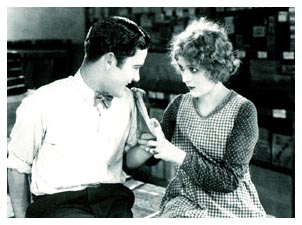 the
family do as it pleases. Her sister is a flapper in he truest
sense of the word. She dates a crook and, with a flaring temper,
constantly fights with her parents.
the
family do as it pleases. Her sister is a flapper in he truest
sense of the word. She dates a crook and, with a flaring temper,
constantly fights with her parents.
It is in the midst of one of these fights that Maggie and Joe arrive at the house after the truck ride home. Maggie invites him to stay for supper before realizing the turmoil they are about to walk into. She explains that her sister is practicing for a play and asks Joe to wait on the porch. As he sits there, he continues to hear the row, watches as the sister's shady boyfriend comes in, and then sees a policeman come to the door trailing the boyfriend. In order to keep Joe from realizing what's going on, Maggie tells the cop, "What a lovely costume! You look exactly like a policeman!" The entire sequence is hilarious (Buddy Rogers does a good job of simply sitting on the porch and providing quizzical looks at this charade), but it also provides character development for Maggie through a greater insight into the dynamics of her family. This "richness" of character is one more thing that sets Pickford's film a notch above the rest.
A quote from Scott Eyman's Mary Pickford: America's Sweetheart (Donald I. Fine, Inc., 1990) provides an interesting observation about this element of the story. "'My Best Girl' captures the homely myths of an America that was still poised awkwardly between rural values and urban lifestyles. In the mingling of shame, devotion and impatience that Maggie displays towards her family, and in Mary's smooth paring with the youthfully ardent Buddy Rogers, which is, even without hindsight far more emotional in nature than the normal love interests her films usually displayed, it is clear that, in a way that Mary herself might not have understood, 'My Best Girl' served as some sort of emotional autobiography."
Although the film is filled with one good sequence after another (there are no slow moments in the story), one that stands out is the evening when Joe takes Maggie back to his house. Of course, Maggie still doesn't know Joe is the store owner's son, but Joe insists, "You remember Merrill's slogan -- we're all one big happy family. Let's take him upon his word." As a lark, Mary agrees, although she balks at the front door and tries several times to get Joe to give up the escapade. With the cooperation of the butler, Joe pulls it off, even to the point of having supper served to them. It all comes to an end when Joe's parents arrive home with Joe's fiancée. It is a very poignant moment when the fiancée runs up and kisses Joe, and then the camera captures the shock and hurt on Maggie's face.
Quite often one is reminded of the source of Mary's movie training by some of the devices she uses in her films. The result of her apprenticeship with D.W. Griffith can be seen in the little touches that add so much to her filmmaking. For example, before going to Joe's house, they walk hand-in-hand down the street that evening stopping to look in a department store window. A room of furniture is arranged in a very domestic scene with the dummies for a mother, father and child relaxing at the end of a day's work. Maggie comments, "It must be wonderful to spend an evening like that after supper," again a throwback to the instability of her family. After the revelation at Joe's house that he's engaged, Mary leaves in the pouring rain, tears filling her eyes. She goes back by the store window and looks longingly one more time at the domestic scene. As she's standing there, the lights go off in the window as if to indicate that that the lights have gone off on her dream, as well. The symbolism is obvious and adds so much to the sentimentality of the moment.
Anyone who has viewed Mary Pickford's output of silent films
cannot doubt what a superb actress she was. She continued to exhibit
that in "My Best Girl," indicating a refinement and
improvement on this skill as her career progressed. Although there
are many scenes where her exceptional acting skill is called upon
(such as the one above), the movie is culminated by possibly the
best such moment in the film. Hurt at the outcome of events, Maggie
has resigned herself to being the caretaker of her dysfunctional
family for the rest of her life. Joe's father arrives at her house
unexpectedly and offers her $10,000 to 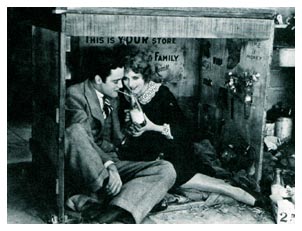 forget
Joe. Then Joe arrives, and not realizing his father is there,
asks Maggie to come with him to Hawaii. They'll be married on
the ship. Thinking it's best for Joe, Maggie, tears streaming
down her cheeks, tries to make Joe believe she's a golddigger
and her relationship with him was all for money. Joe sits in the
chair, saying nothing, letting her go on, but obviously not believing
her. His silence induces her to continue. She claims to be a "jazz
baby," puts on a record and begins to dance. She lights a
cigarette and then puts lipstick on, smearing it above her lip.
The harder she tries, the more the tears flow, until, eventually,
emotionally drained, she falls into Joe's lap. There is no question
that Mary Pickford was one of the finest actresses of the silent
screen.
forget
Joe. Then Joe arrives, and not realizing his father is there,
asks Maggie to come with him to Hawaii. They'll be married on
the ship. Thinking it's best for Joe, Maggie, tears streaming
down her cheeks, tries to make Joe believe she's a golddigger
and her relationship with him was all for money. Joe sits in the
chair, saying nothing, letting her go on, but obviously not believing
her. His silence induces her to continue. She claims to be a "jazz
baby," puts on a record and begins to dance. She lights a
cigarette and then puts lipstick on, smearing it above her lip.
The harder she tries, the more the tears flow, until, eventually,
emotionally drained, she falls into Joe's lap. There is no question
that Mary Pickford was one of the finest actresses of the silent
screen.
Buddy Rogers is also key to the film, and it's hard to imagine someone else in the role who would have brought it the boyish enthusiasm and charm that he did. The fact that he was 11 years younger than Pickford and infatuated with her (this has been well documented many times) certainly helped the charm of the movie.
At 23 years old, Rogers had not been around Hollywood long and was actually a reluctant actor having tried it out at his father's insistence. He only had one major role, and a major role it was, as one of two lead roles in "Wings" (1927) which he had just completed before coming to Pickford.
According to Brownlow, "Rogers heard that Pickford was casting and went for an interview on a hopeful whim. A dozen others had assembled by the time he arrived, and his heart sank. Rogers remembered that the first time he saw Mary face-to-face was when she answered his knock at her dressing room door with 'Won't you please come in?' Her golden curls hung well below her waist. He was so dazzled by this apparition that he could not recall what he said or how he got the part -- but he did get it. And even more than 'Wings,' it made him a star. He became known as America's Boyfriend."
Eyman recounts a slightly different sequence of events in his biography of Pickford. "Shortly after 'Wings' finished production, Hope Loring, a writer friend of Rogers' who was working on the script of a story Mary had brought from Kathleen Norris, invited him to a dance, a monthly white-tie-and-tails social engagement called the Mayfair. There, she told Rogers to meet her for lunch the following Monday. 'We drove over to a studio that I didn't realize at the time was United Artists. We drove in front of a beautiful bungalow, and Hope let me out while she parked the car. I rang the bell and Mary opened the door. And that was it.'" This story makes sense since Loring helped write the screenplay for Rogers' movie "Wings."
As for Rogers' crush on Pickford, Booten Herndon reported in his double biography Mary Pickford and Douglas Fairbanks (W. W. Norton & Company, Inc., 1977), "'I think he's got a crush on me,' (Pickford) told Frances Marion, giggling with pleasure like the shopgirl she was playing."
Brownlow said cameraman Charles Rosher "first noticed something between them during the sequence inside a packing crate. When the scene was over, he could not get them out."
"During production of 'My Best Girl,' it very quickly
became clear that Rogers had developed a crush on his co-star,"
Eyman said. "There is no question that the attentions of
such an attractive younger man as Buddy did much to assuage Mary's
fears 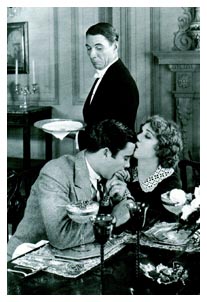 about the parade passing her by."
about the parade passing her by."
Certainly the chemistry between the two added much to the film, and the famous sequence inside the packing crate is evidence of this. In no Pickford movie before had there ever been such a drawn-out, sensitive and loving kiss as there was between Rogers and Pickford.
There is an almost universal consensus about the greatness of "My Best Girl." Eyman said, "'My Best Girl' shows an emotional richness and maturity, as well as an increased technical sophistication, that makes it a particularly charming example of Mary's filmmaking expertise." Brownlow called it "a simply, straightforward and charming comedy."
Welford Beaton in The Film Spectator (Oct. 15, 1927) eulogized, "A romance that will take its place among the most beautiful that have been presented on the screen . . . For the first time, we have Mary in a straight love story, and unless her untold millions of admirers throughout the world hail this picture as her greatest, I will be much surprised."
Variety (November 9, 1927) gave more moderate praise. "Plenty of hoke in this latest Mary Pickford. It's the old tear-behind-the-smile, clean, wholesome, family type of fun. No crocodiles in this one. May be less art, but more box office. . . The cast is good. Charles Rogers overcomes his good looks with a display of naturalistic humanness. In this instance he is more the old type of screen hero. Miss Pickford is her usual sweet and likable self . . ."
And, of course, true to form, The New York Times (November 7, 1927) couldn't resist mixing thorns with the roses. "It is a subject that causes one to reflect that Miss Pickford would do better to employ her talent in a more intelligent type of picture. In this production there are one or two episodes that are worthy of being links in a far more satisfactory narrative, and even in these sequence, there are occasional bromidic touches that the director, Sam Taylor, would have done well to keep out. As it stands, this film is hardly for adult minds, but it is a subject that will be much enjoyed by children."
But, of course, Mary's fans loved it. The film cost $483,103 to make. It grossed $81,000 in a three-week run at the Rialto in New York. Its total domestic gross was $1,027,757.
As a side note, the original working title of "My Best Girl" was "Paradise Alley."
Fortunately, "My Best Girl" is preserved in immaculate condition (only a couple of noticeable flaws here and there), and has been brought to DVD by Milestone Film and Video to whom we all are grateful for the Mary Pickford series of films that have been brought to home video. It includes an original symphonic score by David Michael Frank which is excellent. The only criticism is that in some of the humorous sequences, the music could have been more appropriate for comedy and less "serious.